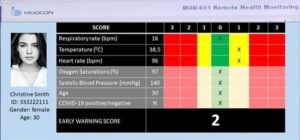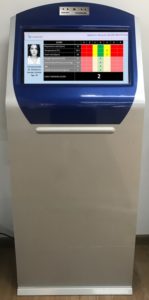Vital signs are measurements of the body’s most basic functions. The following main parameters are normally monitored by medical professionals to identify the illness:
- Body temperature
- Pulse rate
- Respiration rate (rate of breathing)
- Blood pressure (Blood pressure is not considered a vital sign, but is often measured along with the vital signs)
Vital signs are useful in detecting or monitoring medical problems. Vital signs you may have already noticed, when you get sick, your resting heart rate tends to increase and your heart rate variability tends to decrease.
While you might see these changes during the early stages of an infection, we often don’t experience obvious symptoms. The immune system and the central nervous system work together in complex ways to target a foreign virus even before we’re aware that we are sick.
 When infections become severe enough, one coordinated attack these two systems produce is the febrile response, commonly known as a fever. When the immune system detects a foreign pathogen such as a virus or bacteria, it sends a signal to the brain to increase the body’s core temperature, causing the sympathetic nervous system to respond by producing more heat. When the temperature rose by 1 degree C, the heart rate increased on the average by 8.5 beats per minute. When infections become severe enough, one coordinated attack these two systems produce is the febrile response, commonly known as a fever. When the immune system detects a foreign pathogen such as a virus or bacteria, it sends a signal to the brain to increase the body’s core temperature, causing the sympathetic nervous system to respond by producing more heat. When the temperature rose by 1 degree C, the heart rate increased on the average by 8.5 beats per minute.
By creating a personal baseline while you are healthy, vital signs daily measurement can be used to identify signs of illness sometimes before you actually feel sick and potentially before a doctor – without recent data of what your personal “normal” looks like – would recognize that something was wrong. Vital signs monitoring (Body temperature, Pulse rate and Respiration rate) daily measurement can serve as an early detection system and useful in detecting medical problems, such as those demonstrated in persons infected and fighting COVID-19. Being included in access control procedures, vital signs screening can be effectively used to provide facility-based surveillance for healthcare-associated infections, including infections in healthcare workers and inpatients, which is one of core components of COVID-19 infection prevention and control. |
 The human body is very complex and simply measuring temperature is not an effective way to determine sickness. According to the latest FDA guidelines for diagnosing COVID-19, “High body temperature does not necessarily mean a person has a COVID-19 infection. All fevers measured by thermal imaging systems should be confirmed by another method and followed by more diagnostic evaluations for other symptoms, as appropriate”.
The human body is very complex and simply measuring temperature is not an effective way to determine sickness. According to the latest FDA guidelines for diagnosing COVID-19, “High body temperature does not necessarily mean a person has a COVID-19 infection. All fevers measured by thermal imaging systems should be confirmed by another method and followed by more diagnostic evaluations for other symptoms, as appropriate”.
Modcon’s latest VsScan (MOD-601) is a real-time screening analyzer enhanced with two 3D sensors, a RGB sensor, temperature transmitter, and thermal sensor that allows for thermal imaging. Modcon’s AI (Artificial Intelligence)-based video analytics software collects and calculates data and vital signs values. Additionally, there is a display of measurement results that compare results with normal ranges. Once data is collected and read, it determines an output for access control.
Vital signs monitoring (Body temperature, Pulse rate and Respiration rate) is mainly used at control gates and enables the most accurate and fastest screening of persons at the following locations:
- Industrial Facilities
- Hospitals
- Marketplaces
- Offices & Government Buildings
- Airports & Border Control
- Retirement Homes
- Schools and Universities
| Body Temperature | Heart Rate (HR) | Respiratory Rate (RR) | |
| Sensors | Thermal sensor
RGB sensor 3D sensor RTD sensor |
RGB sensor
3D sensor RTD sensor |
Thermal sensor
3D sensor RTD sensor |
| Detection accuracy | ± 0.5 °C | ± 5 BPM | ± 2 BPM |
| Measuring speed | 0.7 – 2 seconds | 10-15 seconds | 10-15 seconds |
| Detection Distance | 0.2-2 m | 0.5-1 m | 0.5-1 m |
The implemented in VsScan early warning score (EWS) is based on a guide used by medical services to quickly determine the degree of illness of a patient. It is based on the vital signs which were developed in the late 1990s when studies showed that in-hospital deterioration and cardiac arrest was often preceded by a period of increasing abnormalities in the vital signs.
The resulting observations are compared to a normal range to generate a single composite score, based on the following diagram (an early modified EWS):
| Score | 3 | 2 | 1 | 0 | 1 | 2 | 3 |
| Respiratory rate (breaths/min) | >35 | 31-35 | 21-30 | 9-20 | <7 | ||
| Temperature (C) | >38.9 | 38-38.9 | 36-37.9 | 35-35.9 | 34-34.9 | <34 | |
| Heart rate (bpm) | >129 | 110-129 | 100-109 | 50-99 | 40-49 | 30-39 | <30 |
In a pandemic like COVID-19, rapid assessment of persons is essential. A fast and easily calculated score, such as NEWS (National Early Warning Score) could help to provide facility-based surveillance for healthcare-associated infections, including infections in healthcare workers and inpatients, which is one of core components of infection prevention and control.
The implemented in VsScan (MOD-601) vital signs screening and early warning functionality, enables to effectively perform multi-parameter screening to identify COVID-19 infected persons. NEWS methodology can be effectively deployed using the early warning score data provided by MOD-601.






